If you’ve followed this blog for long, the term habitat heterogeneity won’t be unfamiliar. Neither will the phrase ‘shifting mosaic of habitat‘. I’ve spent a lot of words trying to describe the importance of both, as well as various tactics that can create them. Today’s post is dedicated to illustrating what habitat heterogeneity can look like by sharing some photos taken from within the last week across several hundred acres of grassland at our Platte River Prairies. Cody Miller, our preserve manager, is constantly looking for new management ideas to experiment with, and we still have a lot to learn, but we feel pretty good about the way the habitat looks right now.
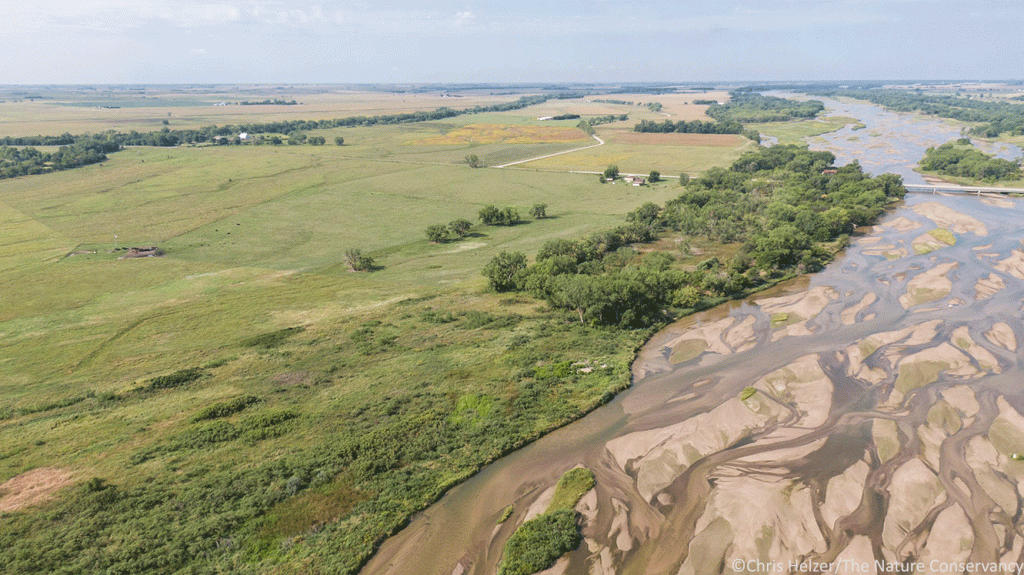
All the photos below were taken mostly from within one management unit of about 425 acres. I’ve tried to represent the wide variety of habitat patch types currently available across that management unit. That habitat ranges from short/sparse to tall/dense vegetation, with lots of interesting variation in-between. For the most part, each of those habitat patches looks significantly different than it did a year ago, which is where the ‘shifting’ part of a ‘shifting mosaic’ comes into play.
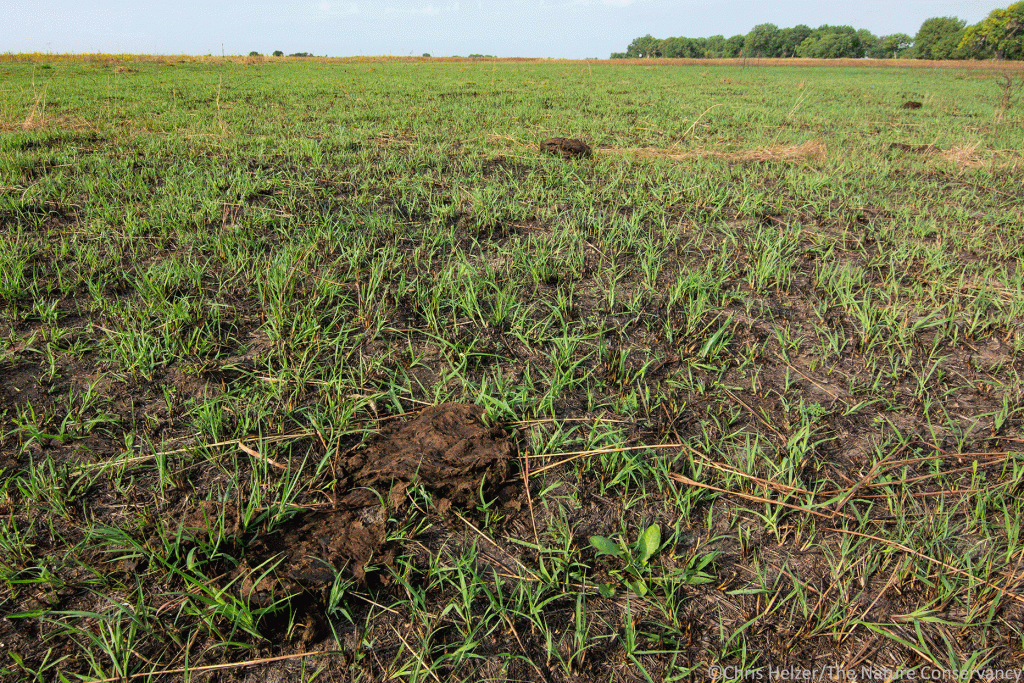
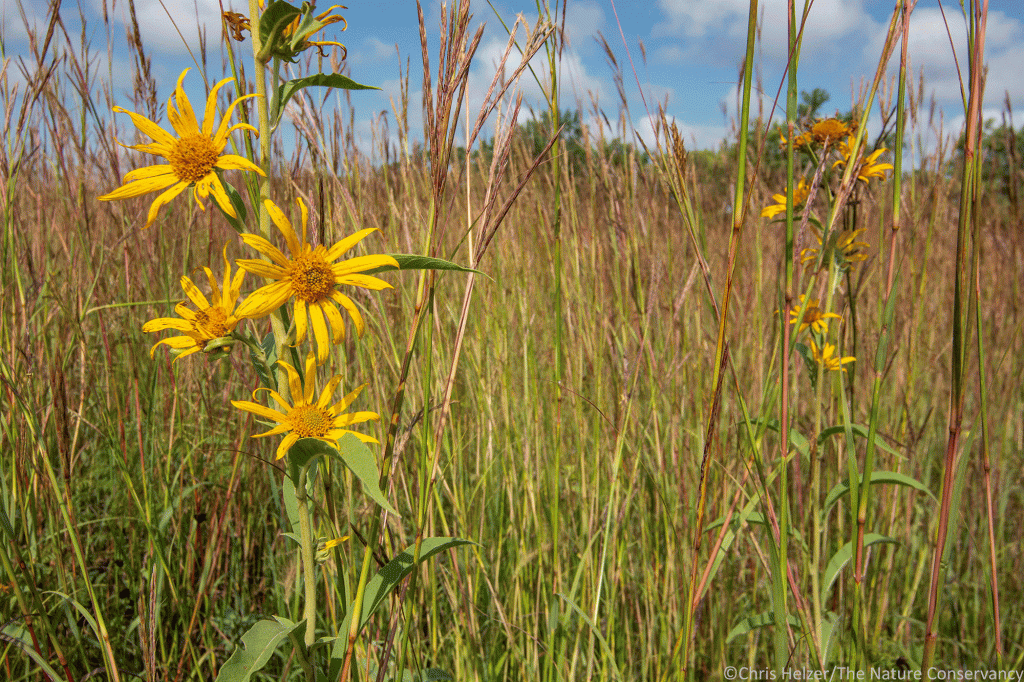
Most of the heterogeneity seen across those 425 acres has been created with recent prescribed fire and grazing treatments. Some, though, has developed more slowly over time, through various restoration projects. Those projects include the conversion of cropland to prairie with diverse seed mixes of 180 or more species. They also include restoration of unplowed, but degraded prairie via overseeding of some missing plant species.
The creation and enhancement of plant diversity adds complexity to the habitat structure by through the architectural variety among plant species. A diverse plant community also helps ensure abundant food and other resources for pollinators, herbivores, predators, and other role players in the prairie. Even more importantly, it fosters ecological resilience, which will help keep all the ecological communities viable through droughts, floods, disease outbreaks, and other stresses. In return, a shifting mosaic of heterogeneous habitat supports diverse plant communities by making sure each plant gets a chance to thrive now and then, regardless of what kind of competitive environment it needs.
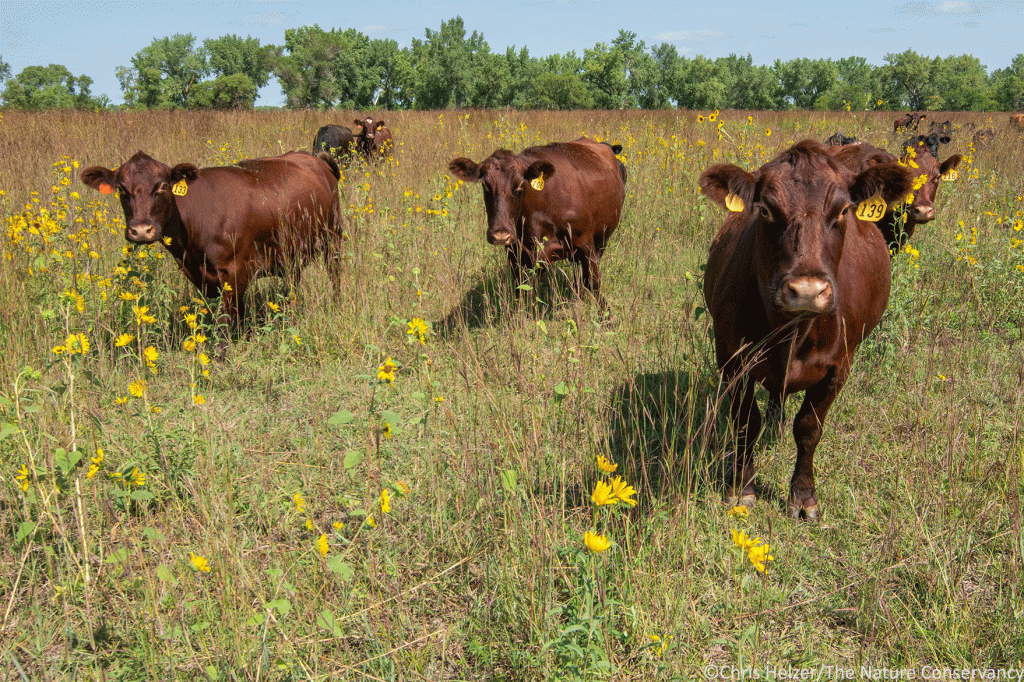
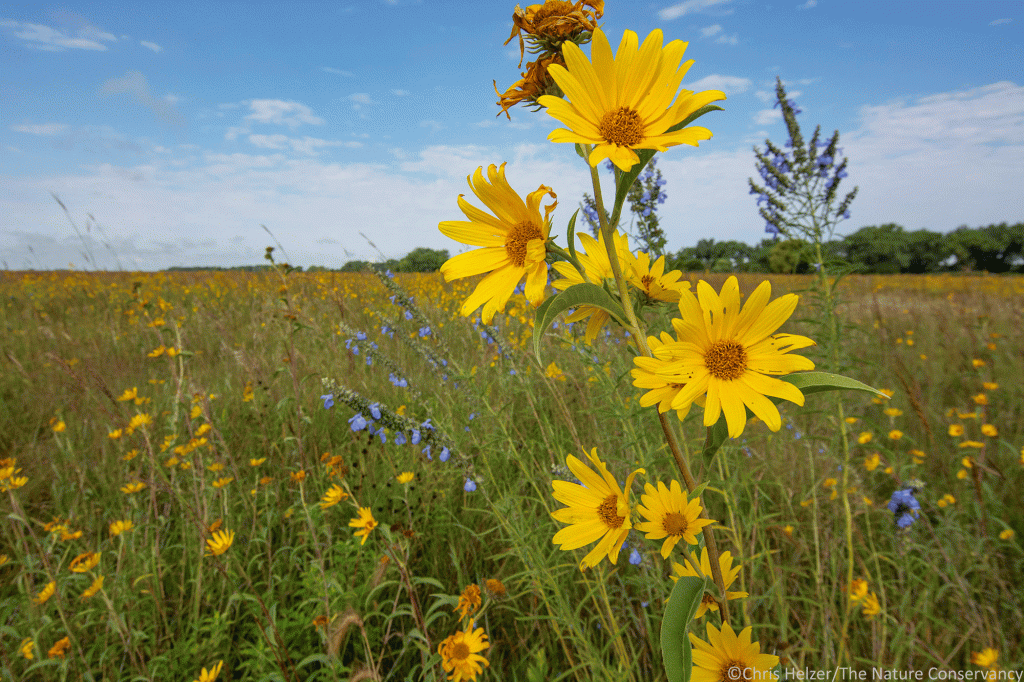
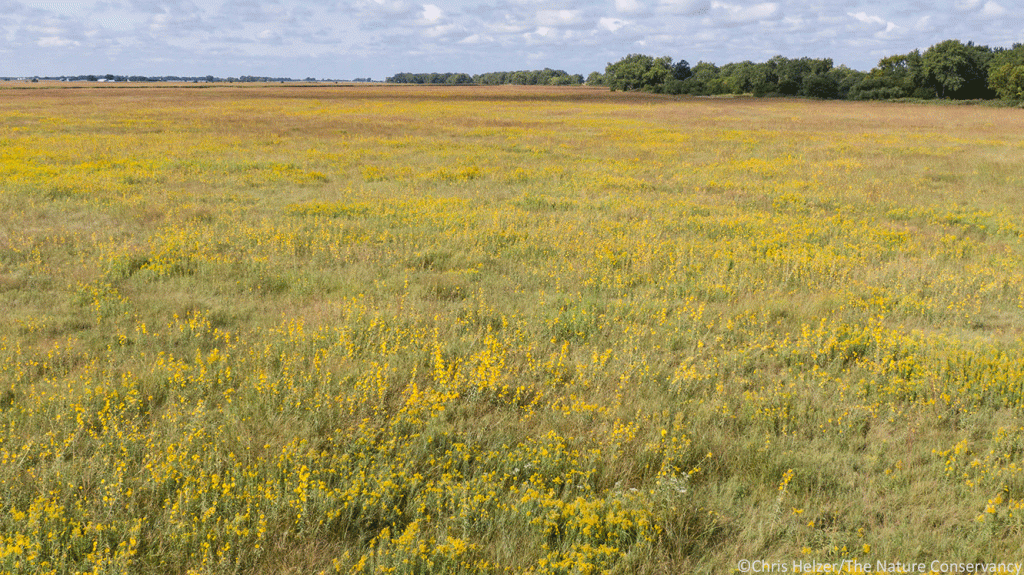
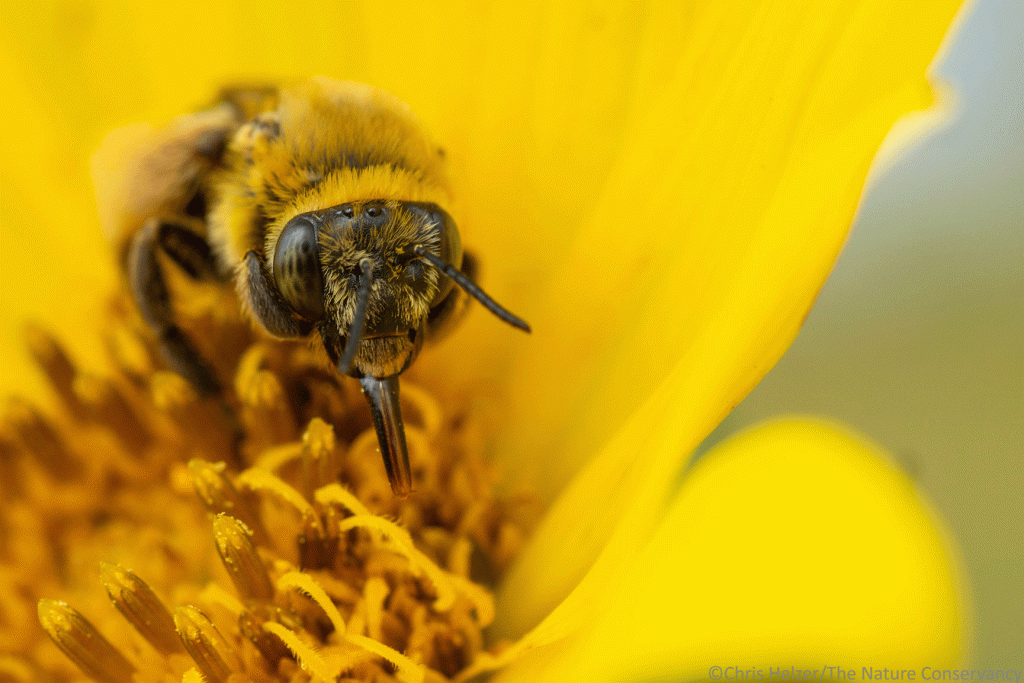
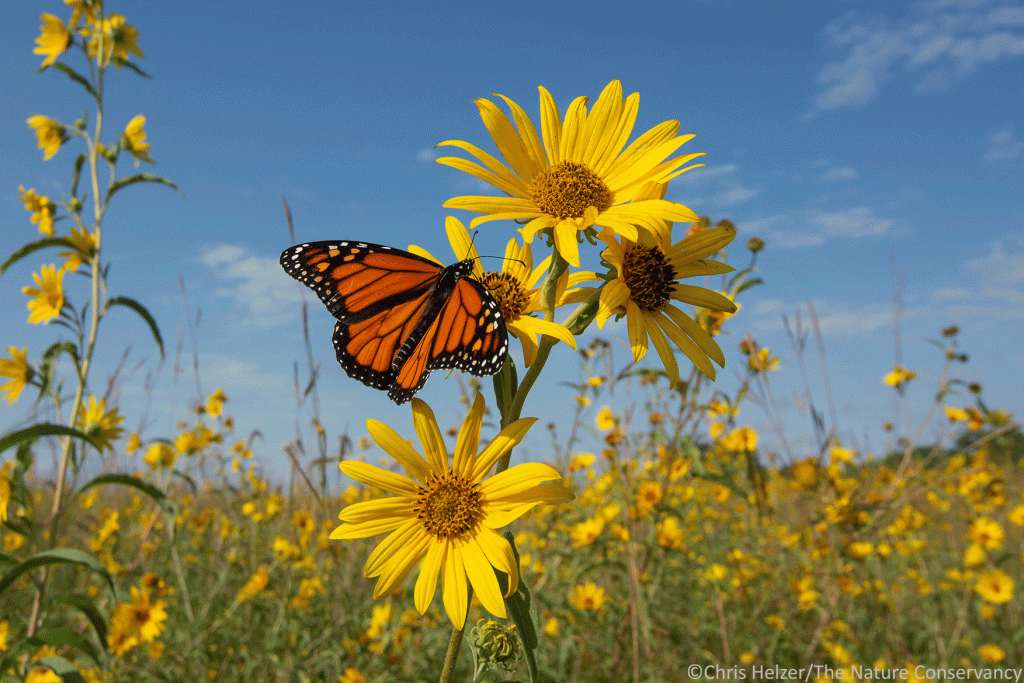
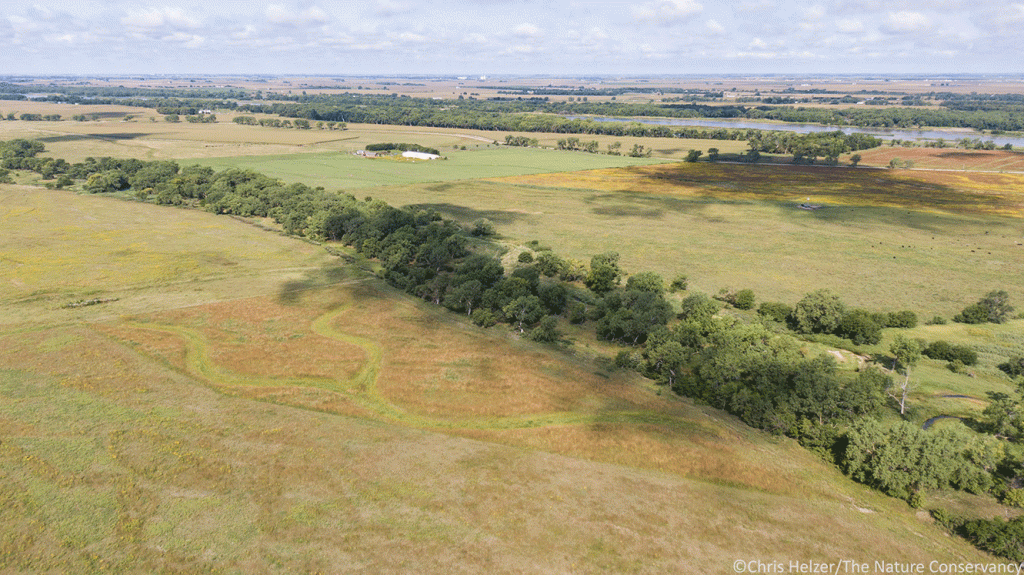
I’ve recently become enamored of tile spades as a way to help quantify habitat structure in a way that’s easy to see. In the three photos below, you can see the same spade stuck in the ground in different locations within a management unit. One herd of cattle has access to all three of the locations, but is grazing each of them very unevenly, resulting in heterogeneous habitat. Note how much of the spade’s blade is visible in each photo.
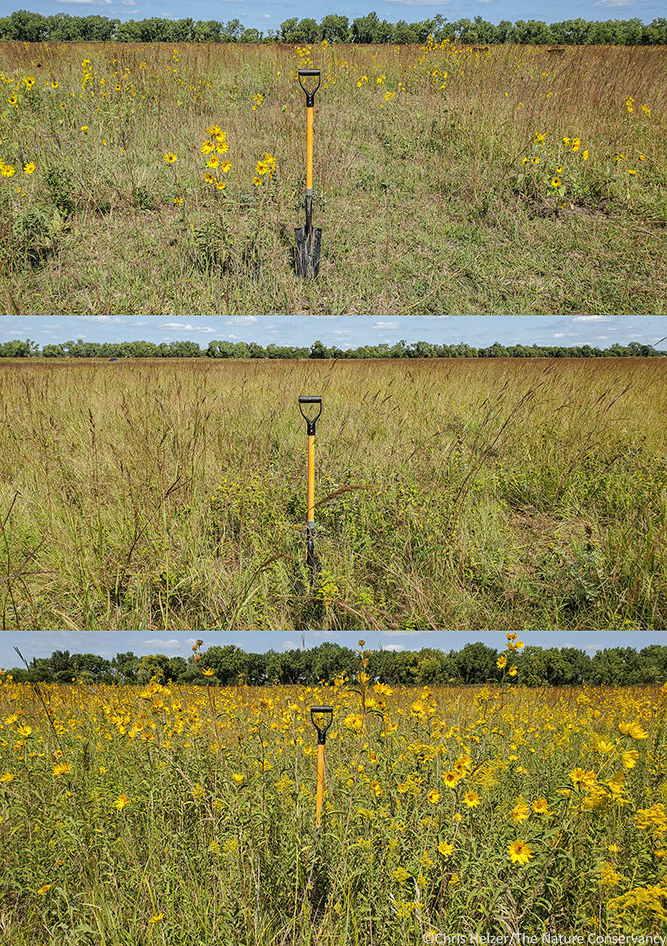
Again, we’re far from having everything figured out, and Cody and I are frequently talking about the numerous questions we want to answer next. Some of those questions require us to collect data to get answers, but for others we just need to try some new ideas and get a feel for how they work. These days, my job is to share ideas and experiences I’ve had, help measure the results of Cody’s management and restoration practices, and then work with Cody to incorporate what we learn into what he tries next. Not all our ideas work, of course, but I’m really happy with the way these prairies have changed over time and the direction in which they’re trending.

I assume neighboring farmers/ranchers wouldn’t appreciate prairie dogs near to their lands. But I’m absolutely sure prairie dogs would be good for your prairie restoration. It is difficult, and is never going to be perfect, when keystone species of the historic ecosystem are missing.
Dear Chris, I love your posts and have learned a lot from them.We have 200 acres in the hilly driftless area of SW Wisconsin.We have been working for 25 years to return the parts that should be prairie andsavanna back into those habitats, mostly by cutting brush and trees and using fire.We don’t have the option for grazing, as there are no fencelines on the propertyany longer. Can we use mowing as an alternative? Even that we will only be able to use in a couple of places that are flat enough. We do burn in both the spring andthe fall, is that enough to keep the grasses from becoming totally dominant?Any other suggestions you have as to how to increase diversity and heterogeneity would be welcome!Thanks, Peggy TimmermanLone Rock, WI
Hi Peggy, Sounds like an awesome project! The effects of frequent fire in Wisconsin seem to be pretty different from what we see in Nebraska, or at least they can be. You might not have issues with grass dominance in the same way we do.
I’d recommend thinking about a couple things. First, in terms of fire, make sure you’re leaving plenty of refuge area each time you burn, especially if your site is isolated from other grassland areas. That will help make sure that populations of insects and other animals don’t get wiped out by any one fire or by too many fires in rapid succession. If you can burn some areas in the spring and others in the fall each year (not always the same sites in the same season, hopefully) that’ll help, but even so, it might be worth leaving some areas unburned each year. These are tough calls to make, though, when you’re trying to fight off brush, so don’t let me talk you into something that hamstrings your efforts. Again, if there are neighboring areas that have similar habitat and aren’t being frequently burned, that makes things easier.
In terms of making things patchy, other things to consider would certainly include mowing if/where that’s an option. You can mow at different times of year than you can burn, and you can mow at different heights and in different patterns (you can create broad swaths of mowed areas, but also make scattered patches/strips of various sizes to mix things up. You might also experiment with mowing a patch multiple times in the same year and then allowing it to rest all of the next year. Etc.
You can also create patchiness with fire, of course. Apart from burning patches at different times of year (and leaving some patches unburned) you can also create more patchy burns – if that’s desired – by burning areas that were mowed and have less fuel or by burning on days with higher humidities. Or you could mow patches within an upcoming burn unit to prevent them from burning when the rest of the area around them burns.
Those are just examples, so use your own creativity to do what you can and what makes sense for your site and the amount of time you have.
Most importantly, experiment in small patches and see what kinds of results you get from treatments so you can adapt over time. With 200 acres, you’ve got room to play. It might be interesting to see what a summer fire looks like in a small area. Or what mowing repeatedly across a season (2-4 times?) looks like in terms of how that patch recovers over the next couple years. Maybe that kind of disturbance will create some interesting plant community responses in addition to different habitat structure or maybe it’ll just be a invasive plant disaster (but don’t be afraid of a pulse of short-lived ‘weedy’ native plants – if they give way when perennials recover that ‘weedy patch’ can be a valuable habitat type). That’s why small scale experiments are the way to start. You might learn things that really help both you and others in the area if you’re willing to stretch a little.
Best of luck with your restoration progress. Keep up the great work!
I just want to say that love the phrase “shifting mosaic” I’m bound to use it in helping people to start understanding prairies. And I’m eagerly awaiting your next book for the public.
a couple of questions on your grazing.
1) are the cattle contained in the same area to graze it continually?
2) if not how often are they moved?
3) are you familiar with mob grazing?
thanks
Dirk
Hi Dirk,
This particular pasture has been managed with a modified patch-burn grazing approach. Cattle have access to one big pasture, with recently-burned patches that they’re hitting harder and less recently-burned patches they are barely touching. In addition, though, we periodically fence off large chunks of the pasture so they get a full year of rest once, at least once every 4-5 years to make sure favored plants get to escape grazing for that year and bloom/reproduce.
Yes, I’m familiar with mob grazing and am not a fan. Besides the labor costs of having to move fences/cattle all the time, it also doesn’t create the kind of longer-term grazing impacts and longer-term recovery periods we’re looking for. We want each of our habitat periods to last long enough that they can be used by animals for a breeding season, for example. Also, the patches recovering from a season of fairly intense grazing are some of our most unique and valuable habitat conditions and we want areas to spend a year or more in that recovery phase before perennials become dominant again. (Also, the University of Nebraska just finished a nice 10 year study of mob grazing, both on research ranch land and on several private ranches where they just tracked what the ranchers did, and de-bunked much of the mythology around the purported benefits of mob grazing.)
Hi Chris,
Have you or Cody experimented with dodders(Cuscuta spp.)?
I’m interested in their use as a pest control tool(and haven’t found much information), but after reading your blog, I’m curious how they would impact the heterogeneity of a habitat.
Hi Caroline,
We include dodder in our seed mixes and it shows up in scattered locations (whether as a result of the seed we harvest or not I don’t know). It definitely has a small impact, and one that is interesting and valuable at its local scale, but I don’t think it is making a huge difference across our larger prairies. Our dodder is hosted mainly by perennial sunflowers and goldenrods and it makes those plants somewhat smaller within the infested patch, but it doesn’t create the same kind of bare ground, short-cropped plants, or sparse vegetation that grazing and recovery from grazing creates. I’d be skeptical that it would be very effective for pest control, but I guess it would depend upon what Cuscuta species you’re looking at and what host species you’re trying to control. For us, it never spreads very far and just occurs in small patches each year (in different locations).
Important and interesting work here. How many acres do you think is realistic to manage to achieve the type of habitat heterogeneity you are describing, since grazing, fire, and haying can have such different effects? You are working with 425 acres, with good size areas with different structures. What do think is the minimum size to achieve the kind of long term results you are looking for?
Hey Patrick. It’s a good question I can’t fully answer. Heterogeneity is important all scales, from 1/4 acre to 10,000 acres or more. The target organisms change with scale, though. You won’t be getting a very robust grassland bird community in a 2 acre grassland surrounded by crops or city. But you could have a pretty diverse invertebrate community if you provide good plant diversity and a variety of habitat patches that represent different kinds of vegetation structure.
The biggest challenges in small prairies include a limitation on the kinds of treatments you can apply. Grazing is more difficult in smaller prairies, though still very feasible in 10-20 acre prairies (and even smaller) if you have infrastructure and a cattle owner willing to work with you on when cattle go in and out. Mowing and fire are much more feasible, though mowing is often limited in steep topography (as in the Iowa Loess Hills…) or where there are lots of trees around.
It’s also really hard to know how big to make habitat patches in very small prairies. We just don’t have enough knowledge about that for me to advise you.
It also matters whether your small prairie is in a matrix of other grasslands or completely isolated. If there are other grasslands, you might be able to look at your prairie as one patch in a neighborhood of other patch types. Or at least you can rely on the matrix to help support populations within your small prairie. There’s more room for error there and a much greater chance that species will survive for a long time within your prairie because there’s a large pool of individuals outside your prairie that can flow in, out, and through your site.
If you have an isolated small prairie, it’s just tough. Ideally, you’d like to create a variety of habitat types (in a shifting mosaic) each year to support the most diverse animal and plant populations across the site that you can. But there’s a decent possibility of eradicating a whole species from the site with one unfortunately-timed management treatment, even if you only burn or mow a quarter of the site. On the other hand, if you manage the site as one big patch, it’s likely that you’ll lose species by not providing them with the habitat they need in a particular year or over a particular time period. The only real answer is to make the prairie bigger through restoration, which isn’t always a possibility. If it’s not, you just have to grit your teeth and do the best you can, knowing that you’re just trying to keep species alive for as long as you can on a slowly sinking ship.
Cheery prospect, huh? The good news is that there seems to be a base of species, which can still be a pretty diverse mix, that can hold on in small isolated prairies for a long time. You might be missing a lot of more ‘sensitive’ species that have needs a small isolated site just can’t provide, but you can still have a pretty and diverse prairie that is worth conserving.
Conversion of cropland to prairie has the long term problem in that natural prairie fungi species and most of the other former biological life in the soil will have been killed off by chemical fertilizers, herbicides, pesticides and fungicides etc.
To get the soil back to anything like what it used to be will take centuries or millennia.
And as you know many plants need different and unique fungi species to germinate and grow.
So, have you ever thought about transplanting appropriate type(s) of topsoil sod from a pristine and healthy prairie into the former cropland’s soil, Chris?
I feel sure this at the very least will speed up the process of restoring prairie fungi species and biological soil life significantly.